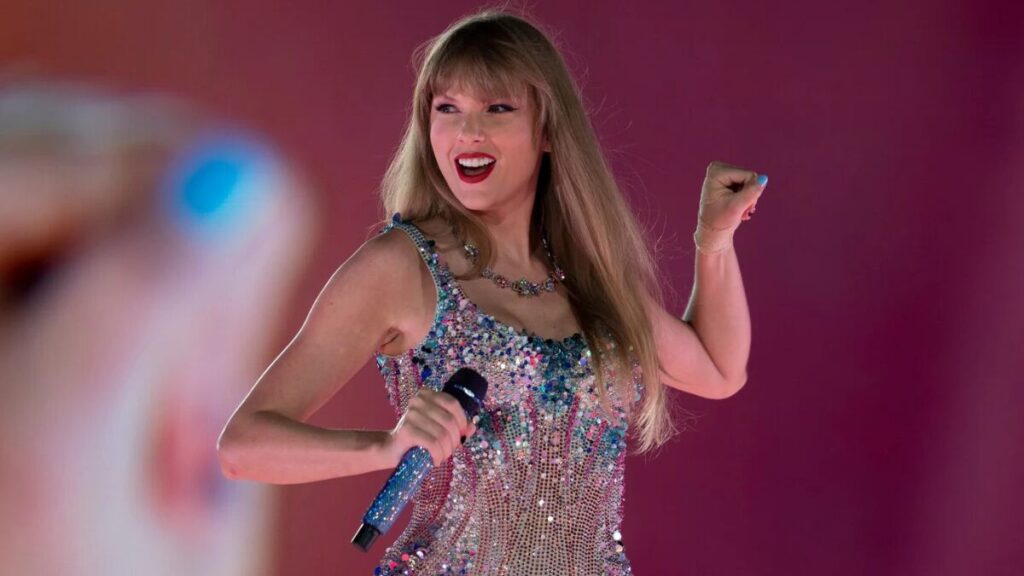At just 16, Taylor Swift stepped onto the Nashville stage with nothing more than a guitar, a diary’s worth of lyrics, and the audacity to dream bigger than the country charts. Two decades later, that dream has scaled into a global empire—transforming her from prodigy to powerhouse, from chart-topper to cultural architect. Today, Taylor Swift is not only celebrated as an artist but recognized as a billionaire business force, with an estimated net worth of $1.6 billion in 2025.
Her story is more than one of platinum records; it’s a blueprint for how creativity, ownership, and reinvention fuel long-term wealth. From reclaiming her masters with “Taylor’s Versions” to building the record-shattering Eras Tour, Swift has redefined what financial independence looks like in the music industry. The phrase Taylor Swift billionaire is no longer a surprising headline but a reminder of how cultural relevance can be converted into lasting economic power.
As this article unpacks her $1.6 billion fortune, it will trace how Swift’s journey is as much a case study in smart strategy as it is in artistry. Because at its core, Taylor Swift’s empire is proof that reinvention, ownership, and vision are the true cornerstones of modern celebrity wealth.
How Much Is Taylor Swift Worth in 2025? Breaking Down Her Net Worth Numbers
When fans and analysts ask, “How much is Taylor Swift worth right now?” the answer is clear: in 2025, Taylor Swift’s net worth is estimated at $1.6 billion, according to Parade. That figure cements her as not only one of the world’s most successful entertainers, but also one of its most savvy business strategists. Publications like Forbes and Bloomberg underscore that this valuation isn’t static—celebrity wealth fluctuates with touring schedules, streaming payouts, and shifting real estate markets. But the underlying truth remains: Swift’s fortune is built on multiple, carefully managed revenue streams.
At the heart of her wealth is The Eras Tour, a global juggernaut that alone added hundreds of millions in gross revenue. Just as crucial is her decision to re-record her catalog, turning Taylor’s Versions into both a creative triumph and a financial windfall. Add in steady income from streaming, publishing rights, and merchandise, and you see a diversified portfolio few musicians achieve. Beyond music, Swift has invested in high-value real estate across New York, Rhode Island, and Nashville, while her selective endorsements—Capital One, Apple, Coca-Cola—reflect quality over quantity.
Here’s a simplified breakdown:
| Source of Wealth | Estimated Contribution |
| Touring (Eras Tour, past tours) | ~$600 million |
| Music catalog & masters ownership | ~$300 million |
| Streaming & publishing royalties | ~$100 million |
| Real estate holdings | ~$80 million |
| Endorsements & brand partnerships | ~$20 million |
Together, these pillars explain how Taylor Swift’s net worth 2025 reached $1.6 billion—and why her empire shows no signs of slowing down.
Where Does Taylor Swift’s Money Come From? Touring, Ownership, and Branding
The Eras Tour: A Historic Revenue Machine
The Eras Tour wasn’t just a concert series—it was an economic phenomenon. From the moment tickets went on sale, demand shattered records, with millions of fans flooding Ticketmaster and sparking congressional hearings over the platform’s failures. Entire cities prepared for her arrival, as hotels sold out, local businesses saw surges in sales, and fans camped outside stadiums just to catch echoes of her 40-song setlist. On paper, the tour is projected to gross over $1 billion, but its ripple effects extend far beyond balance sheets.
Resale tickets soared to thousands of dollars, reflecting the feverish demand and scarcity economics that Swift has mastered. Each night became a cultural event amplified by TikTok livestreams, friendship-bracelet trades, and viral outfit themes that turned shows into communal rituals. By the end of 2023, economists were calling it “The Taylor Swift Economy,” pointing out how her presence could boost a city’s GDP for the weekend.
The Eras Tour proved that live performance, when paired with cultural storytelling, isn’t just entertainment—it’s an engine of financial and social power.
Why Owning Her Music Masters Changes Everything
For years, Taylor Swift’s biggest battle wasn’t against charts or critics—it was over ownership. When Scooter Braun acquired her early masters without her consent, it sparked a global conversation about artists’ rights. Instead of conceding, Swift rewrote the playbook: she began re-recording her catalog as Taylor’s Versions. Today, these albums aren’t just symbolic—they’re revenue juggernauts. With fans choosing Taylor’s Versions over the originals, streaming royalties and licensing fees now flow directly to her.
The difference is staggering. Before, the value of her music was tied to contracts and third-party control; now, Taylor Swift owns her masters, securing both artistic freedom and massive long-term financial payoff. In effect, she turned a setback into a billion-dollar strategy. For younger artists, it’s proof that ownership isn’t a luxury—it’s the foundation of sustainable wealth in the music industry.
Endorsements and Brand Partnerships Beyond Music
Unlike many celebrities who saturate their image with endless sponsorships, Taylor Swift has treated brand partnerships with the same precision she applies to her music. Over the past decade, she has aligned with only a handful of companies—Capital One, Apple, Coca-Cola—each chosen because it fit seamlessly with her brand and audience. That scarcity has become a strategy: by saying “no” more often than “yes,” Swift amplifies the value of every deal she takes.
Financially, these partnerships are estimated to contribute around $20 million to her $1.6 billion fortune—not the largest slice of her empire, but one of the most strategically important. Unlike touring windfalls or record sales, endorsements are long-tail income streams that keep her brand present in everyday culture. For Swift, restraint has translated into credibility, reinforcing her reputation not just as a global pop icon, but as a disciplined business mind who knows the power of scarcity.
Is Taylor Swift Richer Than Beyoncé, Rihanna, and Other Music Icons?
When readers search “Is Taylor Swift richer than Rihanna or Beyoncé?” they’re tapping into one of the most common curiosity points in celebrity finance: the league table of music’s billionaires. In 2025, Taylor Swift’s net worth of $1.6 billion places her firmly among the richest musicians alive, though the dynamics differ depending on how wealth is built.
Rihanna, with an estimated $1.4 billion, edges higher largely because of her stake in Fenty Beauty and Savage X Fenty. Beyoncé, valued at around $800 million, leverages a mix of touring, publishing, and business ventures with Jay-Z, whose fortune surpasses $2.5 billion thanks to liquor brands, music publishing, and investments. Madonna remains one of the highest-earning female artists in history with roughly $850 million, while Drake’s diversified empire puts him close to $250 million.
Here’s how the numbers compare:
| Artist | Estimated Net Worth (2025) | Primary Wealth Drivers |
| Rihanna | $1.4 billion | Fenty Beauty, Savage X Fenty, music |
| Taylor Swift | $1.6 billion | Touring, masters ownership, real estate |
| Jay-Z | $2.5 billion | Music, liquor brands, investments |
| Beyoncé | $800 million | Touring, publishing, Ivy Park |
| Madonna | $850 million | Touring, catalog, investments |
| Drake | $250 million | Music, OVO brand, real estate |
The comparison highlights why the phrase ‘Taylor Swift vs. Rihanna net worth‘ dominates search queries. Swift’s model is unique: while Rihanna leveraged fashion and beauty, Swift proved that touring, ownership, and disciplined branding can stand as pillars of their own, worth a billion dollars. In the hierarchy of the richest female musicians 2025, Taylor Swift isn’t just competing—she’s defining an alternate blueprint.
The Business of Reinvention: How Taylor Swift Keeps Her Brand Relevant
Album Eras as Business Strategy
Each Taylor Swift album isn’t just a musical chapter—it’s a carefully timed brand pivot. With Fearless (2008), she cemented her crossover from country prodigy to pop storyteller, broadening her audience without losing authenticity. Years later, Reputation (2017) flipped the script entirely, trading fairytales for serpents and shadows, a move that transformed public scrutiny into one of her most profitable tours. The economic lesson? Reinvention keeps both fans and markets engaged.
By the time Midnights (2022) arrived, Swift had perfected the art of blending introspection with spectacle, driving vinyl sales, surprise drops, and record-breaking streaming numbers. Now, anticipation surrounds The Tortured Poets Department (2025), positioned as yet another evolution—proof that her artistry doubles as a business engine. Each “era” is more than an aesthetic; it’s a recalibration of merchandise, touring, and cultural narratives. Swift’s genius lies in proving that reinvention is not risky—it’s profitable.
Direct-to-Fan Economics: Limited Vinyls, Exclusive Merch
Taylor Swift has mastered what economists call the “scarcity effect”—and she’s applied it directly to her fans. Limited-edition vinyls in multiple colors, signed CD runs, and carefully timed merch drops aren’t just collectibles; they’re high-margin revenue streams designed to turn fandom energy into measurable profit. Every reissue of her albums, particularly the Taylor’s Versions, comes with exclusive variants that fans race to secure, often selling out within hours.
This direct-to-fan strategy bypasses traditional retail channels, allowing Swift to capture both higher profits and deeper loyalty. For fans, owning a rare vinyl isn’t about resale value—it’s about belonging to the cultural moment Swift creates. From a financial perspective, it’s recurring revenue that adds millions on top of streaming and touring income. By blending art with commerce, Swift proves that scarcity isn’t just hype—it’s an economic engine fueled by emotional connection.
Taylor Swift’s Real Estate and Asset Empire
Taylor Swift’s empire isn’t built on music alone—her real estate portfolio, valued at more than $80 million, reflects the same mix of strategy and storytelling that fuels her career. Each home feels like a marker in her journey, a physical “era” that mirrors her evolution as an artist and businesswoman.
In New York City, she famously turned a Tribeca penthouse into a sprawling multi-unit compound worth over $50 million, often described as her East Coast headquarters. Back in Nashville, where it all began, Swift owns a Greek Revival estate and a condo, together valued at around $8 million, grounding her billionaire lifestyle in her country roots. Out on the coast, her Rhode Island mansion—a $17 million cash purchase—has become the stuff of legend, immortalized in lyrics and Instagram posts as the backdrop for her iconic Fourth of July parties.
A visual map of Taylor Swift’s houses would reveal more than luxury; it’s a narrative of identity, privacy, and legacy. From investment savvy to cultural symbolism, her properties prove that real estate isn’t just shelter for the rich—it’s another chapter in the story of Taylor Swift’s billion-dollar brand.
Beyond Dollars, Why Swift Is a Billionaire Icon
Taylor Swift’s billionaire status isn’t defined by numbers alone—it’s magnified by what economists now call the “Taylor Swift Economy.” Her presence in a city can swell local tourism, filling hotels, restaurants, and shops to the point where mayors openly credit her concerts for boosting GDP. In places like Glendale, Arizona—temporarily renamed Swift City—her tour stops became civic events, not just entertainment. Similar ripples were seen worldwide, where her concerts sparked travel surges and even local policy conversations.

Beyond economics, Swift has shaped political and cultural discourse. Her public statements have mobilized voter registration drives, while her feud with Ticketmaster escalated into a congressional hearing, putting the mechanics of the live music industry under unprecedented scrutiny. Cultural critics argue that Swift is more than a performer—she is an institution, capable of shifting markets and conversations alike.
This synthesis of influence and income explains why her billionaire status resonates differently than most. Taylor Swift doesn’t just accumulate wealth; she generates ecosystems. In a modern world where cultural capital often outweighs financial capital, Swift stands as the rare figure who embodies both.
How Taylor Swift’s Net Worth Was Calculated
Estimating celebrity wealth is never an exact science, and Taylor Swift’s $1.6 billion net worth in 2025 should be understood as an informed approximation rather than a fixed figure. Sources such as Forbes, Bloomberg, and other financial outlets compile their estimates using public reporting, industry data, and historical earnings patterns. Touring revenue, publishing rights, streaming royalties, and real estate valuations are factored in, alongside known brand partnerships and catalog ownership.
However, it’s important to note the limitations. Some details—like private contracts, confidential licensing agreements, and the real-time value of her re-recorded catalog—remain outside public view. Real estate values fluctuate with the market, and touring income is dependent on schedules and global demand. Swift’s earnings from merchandise and limited-edition products are also significant but harder to pin down precisely.
By disclosing these caveats, this article follows the same transparency standards used by reputable wealth trackers. The bottom line: while the exact figure may shift, there is a broad consensus that Taylor Swift’s fortune has surpassed the billion-dollar mark, thanks to a combination of artistry, business discipline, and cultural dominance.
My First Experience at a Taylor Swift Concert
I’ll never forget the night I finally stepped into the stadium for Taylor Swift’s Eras Tour. From the moment I walked through the gates, it felt less like a concert and more like entering a living, breathing city of fans—tens of thousands of people trading friendship bracelets, sequins glittering under stadium lights, whole families dressed to represent different Taylor “eras.” The energy was electric, humming with the anticipation of a collective experience everyone knew would be historic.
When the lights dropped and Swift appeared on stage, the sound was indescribable—half scream, half hymn. For three hours, I watched not just a performance, but a masterclass in cultural connection. Every song felt personal, every era a reminder of how her music had scored different chapters of our lives. Around me, strangers cried, danced, and sang in unison, bonded by lyrics that had become communal anthems.
What struck me most wasn’t just the spectacle, but the scale of devotion. It revealed why Taylor Swift’s billionaire headlines ring true: her fortune is built not just on records or tours, but on a rare ability to mobilize millions emotionally and economically. That night, it was clear—this wasn’t just entertainment. It was cultural infrastructure.
Taylor Swift as the Blueprint for a New Celebrity Mogul Era
Taylor Swift’s rise to billionaire status is more than a financial milestone—it’s a signal of how celebrity power has evolved in the 21st century. Her empire is built on three pillars: ownership of her art, constant reinvention of her brand, and the ability to convert cultural influence into economic value. Few artists have managed this trifecta with the precision and intentionality Swift has displayed.
By reclaiming her masters, she reframed the industry’s conversation around creative control. Through her “eras,” she proved that reinvention isn’t risky—it’s essential to longevity. And with the Eras Tour, she demonstrated that live performance, amplified by digital storytelling, can transform concerts into global economic events. Each move shows that wealth today is not just about diversifying income streams, but about aligning business with cultural resonance.
For future moguls, Swift offers a blueprint: power lies in creating ecosystems, not just products. As a cultural and financial force, her empire shows that “Taylor Swift proves that cultural capital is the ultimate currency in the 21st century.”
Nishant Wagh is the founder of The Graval and a seasoned SEO and content strategist with over 15 years of experience. He writes with a focus on digital influence, authority, and long-term search visibility.














